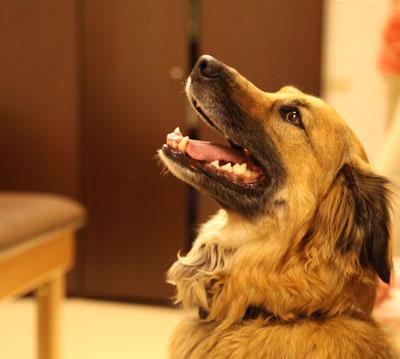
Charlie: Walking the Walk
Wednesday, August 3, 2016
Charlie, Charles or Sir Charles, as he is commonly referred to, is walking with his head held a little higher these days. Charlie is a member of Oklahoma State University’s Pete’s Pet Posse, an on-campus pet therapy dog program. The 3 ½ year-old mixed breed dog belongs to Kendria Cost of Westport, Okla. Cost rescued Charlie in April 2013.
“One of the big things that we promote with our Posse dogs is wellness, of course, because they are part of our America’s healthiest campus wellness initiatives,” explains Dr. Lara Sypniewski, Charlie’s veterinarian at OSU’s Veterinary Medical Hospital. “Charlie was a rescue dog so when he came to Kendria, he was a little bit underweight. And after a year or more of love, he ended up being a little bit overweight. Even though Kendria had done a lot of things to try to get the weight off of him, it just never seemed to happen.”
“He had gained a little weight,” admits Cost. “I changed his food several times. He was exercising. We were walking every day, increasing our route, doing a lot of different things to try to help him lose weight and it just was not coming off.
“Probably the defining moment for me was when I brought him to Stillwater to stay with his trainer,” recalls Cost. “She had not seen him in a while. I got out of the car with him and she said, ‘oh, my gosh, he is so fat. I’m so embarrassed. I’m not even taking him to campus.’ And so, honestly, I cried all the way home not even knowing what I could do, how I could change his diet, how I could change his lifestyle to make him healthy and happy.”
“I suggested to Kendria that we approach Charlie’s diet from an Eastern perspective, evaluating his individual needs based on his personality, his environment, his stressors, his body type, and his exercise program,” states Sypniewski. “This allowed us to choose the best proteins and carbohydrates to meet his nutritional requirements, while honoring those of his overall body type.”
As an example, Charlie always “runs hot.” He consistently pants, seeks cool places to lay and avoids warm environments. To accommodate this individual need, Dr. Sypniewski recommended using cooling foods for Charlie—utilizing foods that would normally be eaten during the summer season.
“I don’t think you would go to the beach and eat a mutton sandwich for lunch,” says Sypniewski. “But having a nice turkey sandwich wouldn’t be out of the question during the summer months. Thinking seasonally helped us to make the food choices we did to help Charlie cool down. Mom finds new recipes all the time. She makes pupsicles with Greek yogurt and mango. She uses the balanced dehydrated diet as well as home cooked food. We really just switched him over a week’s period of time. Charles loved the food, which was good. I mean he is a food hound so he had no problem eating. He was happy.
“And after a couple of weeks, the difference in him was phenomenal,” continues Sypniewski. “Not only was his hair coat starting to change, it was a lot softer hair coat, he had a little bit more glimmer in his eyes. He had more energy. And then all of a sudden, the weight just started to melt off.”
Within six months, Charlie had lost nearly 20 pounds.
“We did it very slowly, very gradually,” adds Cost. “Wellness is obviously a big focus. We did not want it to come off too quickly.”
“We can always look at what the mainstream nutritional guidelines are but with Charlie we did all of that and it didn’t work,” says Sypniewski. “So I love the idea of having another option and having an owner that was very committed to trying something new and thinking outside the box, having a patient who was really good – he liked the food and he was happy to eat it of course.”
“When you are a dog and you gain weight, people use the code word ‘fluffy’ so he got called fluffy a lot,” says Cost. “We would walk into an office that maybe had not seen him in a while and they would say ‘oh, Charlie, you’re so …. fluffy.’ And you know, we made a joke out of it, but I’m just really happy that people aren’t calling him fluffy anymore. That he’s just made great progress and he does everything that I ask him to do.”
And Dr. Sypniewski reports that the issues Charlie had with discomfort in his hips and elbows all went away as soon as he lost weight.
“And so that’s a big take home to most of my pet owners is that obesity causes arthritis,” adds Sypniewski. “It actually increases the risk of earlier death. So we really try to keep them as thin as possible. Before and after pictures are profound. I give his Mom a lot of credit. She really worked hard and he just looks phenomenal. A great ambassador for wellness.”
Kendria reports that Charlie loves being a Pete’s Pet Posse therapy dog.
“He thinks everyone needs to give him a big ole pat and a belly rub,” she says. “He spends a lot of energy doing that actually. He just loves people. He loves the attention that he gets. He loves making a difference. He’s very intuitive. He understands somebody who needs maybe a little bit of extra attention and he seeks those people out, which is really interesting to watch and it makes me really proud of him.”
Pete’s Pet Posse dogs are trained to interact with people, provide affection and comfort to people in a variety of situations. With therapy dogs petting, touching, and asking questions are encouraged. The OSU Pet Therapy Program has been designed and developed to enhance the wellness of its campus population and contribute to the success of being America’s HEALTHIEST Campus®.
